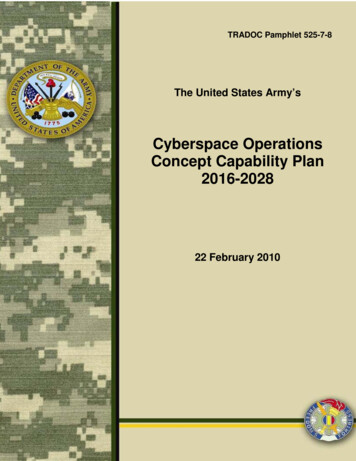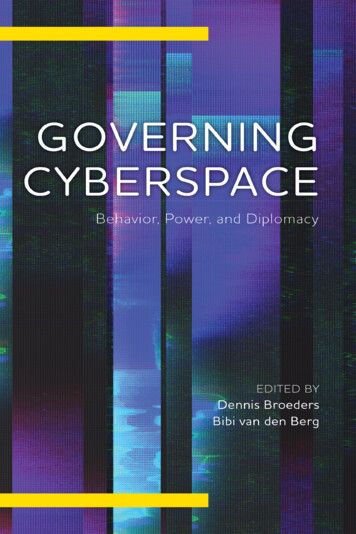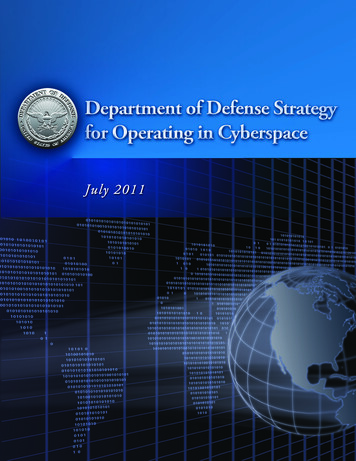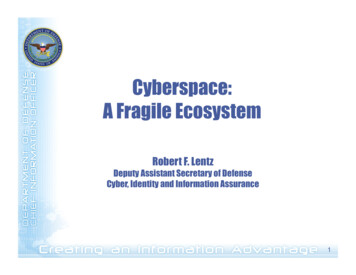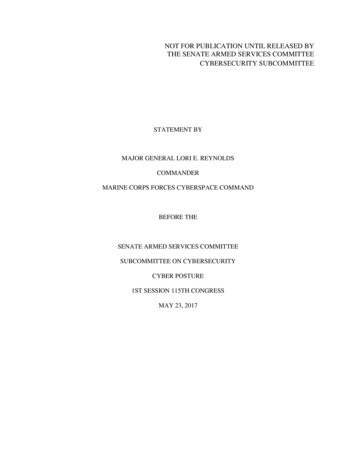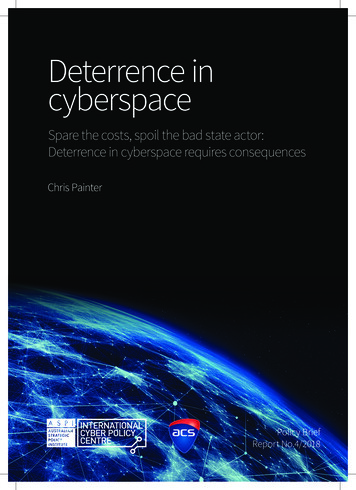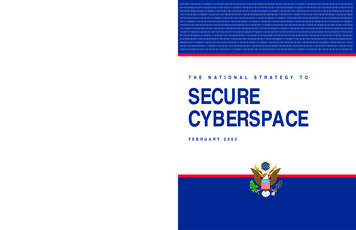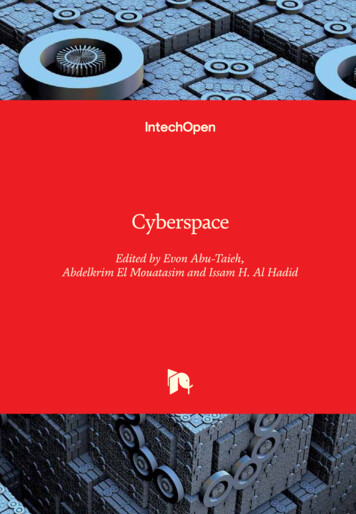
Transcription
CyberspaceEdited by Evon Abu-Taieh,Abdelkrim El Mouatasim and Issam H. Al Hadid
CyberspaceEdited by Evon Abu-Taieh, Abdelkrim ElMouatasim and Issam H. Al HadidPublished in London, United Kingdom
Supporting open minds since 2005
87Edited by Evon Abu-Taieh, Abdelkrim El Mouatasim and Issam H. Al HadidContributorsFabiano Belém, Jussara Almeida, Marcos Gonçalves, Chengbin Wang, Xiaogang Ma, Antonis Danelakis,Konstantinos George Thanos, Stelios C. A. Thomopoulos, Dimitrios Kyriazanos, Andrianna Polydouri,Kassu Jilcha, Evon M.O. Abu-Taieh, Issam H. Al Hadid, Ali Zolait, Carlos Pedro Gonçalves, SlavomírGálik, Sabína Gáliková Tolnaiová, Hanaa Abdallah, Abeer Algarni, K Nalini, Jabasheela L The Editor(s) and the Author(s) 2020The rights of the editor(s) and the author(s) have been asserted in accordance with the Copyright,Designs and Patents Act 1988. All rights to the book as a whole are reserved by INTECHOPEN LIMITED.The book as a whole (compilation) cannot be reproduced, distributed or used for commercial ornon-commercial purposes without INTECHOPEN LIMITED’s written permission. Enquiries concerningthe use of the book should be directed to INTECHOPEN LIMITED rights and permissions department(permissions@intechopen.com).Violations are liable to prosecution under the governing Copyright Law.Individual chapters of this publication are distributed under the terms of the Creative CommonsAttribution 3.0 Unported License which permits commercial use, distribution and reproduction ofthe individual chapters, provided the original author(s) and source publication are appropriatelyacknowledged. If so indicated, certain images may not be included under the Creative Commonslicense. In such cases users will need to obtain permission from the license holder to reproducethe material. More details and guidelines concerning content reuse and adaptation can be found NoticeStatements and opinions expressed in the chapters are these of the individual contributors and notnecessarily those of the editors or publisher. No responsibility is accepted for the accuracy ofinformation contained in the published chapters. The publisher assumes no responsibility for anydamage or injury to persons or property arising out of the use of any materials, instructions, methodsor ideas contained in the book.First published in London, United Kingdom, 2020 by IntechOpenIntechOpen is the global imprint of INTECHOPEN LIMITED, registered in England and Wales,registration number: 11086078, 7th floor, 10 Lower Thames Street, London,EC3R 6AF, United KingdomPrinted in CroatiaBritish Library Cataloguing-in-Publication DataA catalogue record for this book is available from the British LibraryAdditional hard and PDF copies can be obtained from orders@intechopen.comCyberspaceEdited by Evon Abu-Taieh, Abdelkrim El Mouatasim and Issam H. Al Hadidp. cm.Print ISBN 978-1-78985-857-0Online ISBN 978-1-78985-858-7eBook (PDF) ISBN 978-1-78985-721-4
We are IntechOpen,the world’s leading publisher ofOpen Access booksBuilt by scientists, for scientists4,900 123,000 140M Open access books available151International authors and editorsOur authors are among themost cited scientists12.2%Contributors from top 500 universitiesAATE NALYIVCSTICLARCountries delivered toTop 1%DownloadsBOOKCITATIONINDEXINDEXEDSelection of our books indexed in the Book Citation Indexin Web of Science Core Collection (BKCI)Interested in publishing with us?Contact book.department@intechopen.comNumbers displayed above are based on latest data collected.For more information visit www.intechopen.com
Meet the editorsEvon Abu-Taieh, PhD, Associate Professor in The University ofJordan. She has authored or edited 6 scholar books and contributed to more than 8 scholar books. She has more than 55published research studies. She is currently a visiting professorat Princess Noura Bint Abdulrahman University in Saudi Arabia.She served as Acting Dean at the University of Jordan-Aqabafor 3 years and Chair of both the CIS and BIT Departments for2 years. She has more than 31 years of experience in higher education, computers,aviation, transport, AI, ciphering, routing algorithms, compression algorithms,multimedia, and simulation. She has served in many conferences as reviewer andon 4 journal editorial review boards. She was Editor-in-Chief of the InternationalJournal of Aviation Technology, Engineering and Management and has been a guesteditor for the Journal of Information Technology Research.Abdelkrim El Mouatasim, born in 1973, received a Ph.D. degreein Applied Mathematics in 2007 from Mohammadia EngineeringSchool – Mohamed 5 University in Rabat, Morocco. Currently heis an Associate Professor of Artificial Intelligence in the Polydisciplinary Faculty of Ouarzazate, Ibn Zohr University, Morocco.His research interests include: AI, optimization, mathematicalmodeling, and text mining.Issam Hamad Alhadid is an Assistant Professor at the Universityof Jordan. In 2010 he completed his Ph.D. degree at the University of Banking and Financial Sciences in Jordan. Dr Alhadidacted as the Director of the Training and Consultation Center atThe University of Jordan, Aqaba Branch. Dr Alhadid has morethan 40 published research publications on Service OrientedArchitecture (SOA), cloud computing, service composition AI,knowledge base systems, compression techniques, and information retrieval. Also,Dr Alhadid is a Microsoft Certified Business Management Solution Specialist andquality assurance officer, holding an EFQM certificate.
ContentsPrefaceSection 1Internet and CommunicationsXIII1Chapter 15G Road Map to Communication Revolutionby Evon Abu-Taieh, Issam H. Al Hadid and Ali Zolait3Chapter 2Cyberspace as a New Existential Dimension of Manby Slavomír Gálik and Sabína Gáliková Tolnaiová13Chapter 3Research Design and Methodologyby Kassu Jilcha Sileyew27Chapter 4Cyberspace as a New Living World and Its Axiological Contextsby Sabína Gáliková Tolnaiová and Slavomír Gálik39Section 2New Technologies53Chapter 5Cyberspace and Artificial Intelligence: The New Faceof Cyber-Enhanced Hybrid Threatsby Carlos Pedro Gonçalves55Chapter 6Combined Deep Learning and Traditional NLP Approachesfor Fire Burst Detection Based on Twitter Postsby Konstantinos-George Thanos, Andrianna Polydouri,Antonios Danelakis, Dimitris Kyriazanosand Stelios C.A. Thomopoulos79Chapter 7Blind Wavelet-Based Image Watermarkingby Abeer D. Algarni and Hanaa A. Abdallah97
Section 3Data Mining in Cyberspace119Chapter 8Text Mining to Facilitate Domain Knowledge Discoveryby Chengbin Wang and Xiaogang Ma121Chapter 9Tagging and Tag Recommendationby Fabiano M. Belém, Jussara M. Almeida and Marcos A. Gonçalves135Chapter 10Classification Model for Bullying Posts Detectionby K. Nalini and L. Jabasheela149XII
PrefaceParallel to the physical space in our world, there exists cyberspace. In the physicalspace there are interactions between humans and nature that produce products andservices. On the other hand, in cyberspace there are interactions between humansand computers that also produce products and services. Yet, the products andservices in cyberspace don’t materialize—they are electronic, they are millions ofbits and bytes that are being transferred over cyberspace infrastructure.In cyberspace, just like in physical space, essential elements of interactions suchas sellers, buyers, consumers, employees, students, universities, shops, andorganizations do exist. But since the realm is cyberonic, a need for the imaginationis essential. The idea of cyberspace is relatively new to this world, hence the need forthe imagination.This book is composed of 10 chapters that are presented in three sections. The firstsection, Internet & Communications, discusses the topic in four chapters: 5G RoadMap to Communication Revolution, Cyberspace as New Existential Dimensionof Human, Research and Design Methodology, and Cyberspace as New Life.The second section, New Technologies, is composed of three chapters: ArtificialIntelligence, Natural Language Processing (NLP), and Image Processing. The thirdsection, Data Mining in Cyberspace, is composed of three chapters: Text Mining thatFacilitates Domain Knowledge Discovery, Tagging and Tag Recommendation, andClassifications of Posts on Social Media.Evon Abu-Taieh and Issam H. Al HadidThe University of Jordan,Aqaba, JordanAbdelkarim El MouatasimIbn Zohr University,Ouarzazate, Morocco
Section 1Internet andCommunications1
Chapter 15G Road Map to CommunicationRevolutionEvon Abu-Taieh, Issam H. Al Hadid and Ali ZolaitAbstractThe goal of this chapter is to give researchers, practitioners, and students apedestal to get a comprehensive look at the new technology of communicationnamed 5G. The chapter will present an introduction that shows the importance of5G to the different uses of the Internet. Then, the chapter will present two essentialaspects: (1) 5G research in academia and real world and (2) timeline of Gs. Then,the chapter will discuss three aspects of 5G which are, namely, (1) Regulations, (2)security, and (3) the 5 enabling Technologies. Then, the chapter will discuss thereal-life case of South Korea mobile carrier.Keywords: 5G, millimeter waves, small cells, massive multi-input multi-output(MIMO), beamforming, full duplex1. IntroductionThe Internet is nonpareil like running water and electricity; it is a basic need intoday’s world. The influence of Internet on real life reached: Economics, politics,and social. Hence, it created an alternate reality for all factors in life: e-business,e-politics, social networks, e-learning, e-culture, security, Data Science, andBig Data.In economics, the Internet created new type of trade, i.e., e-business and newproducts. Some of the e-business models ranged from e-payment, new tax rules,new currency, and borderless trading. New products are different products otherthan the physical and non-physical products. Non-physical products include movies, music, games, and computer programs. Internet created new trades that did notexist before ranging from delivery services of physical products like delivering food,cloths, etc. to delivering non-physical products like services. According to somereports, “online retail sales worldwide will exceed US 3.4 Trillion” [1] while costs ofthe first year of online retailing ranges from 644 to 31,000 according to eCorner[1]. Others [2] stated that online spending is expected to reach 8.8% of total retailprice increasing from 7.4% in 2016. Also, Gorlamandala [2] stated that UK hasthe highest retail e-commerce sales with 15.6% followed by China with 11.5%.Cross-border is an issue reported by Gorlamandala [2] listing China with 245million and Australia, Indonesia, Singapore, France, and Mexico as countries wheree-commerce sale is in noticeable numbers. Another report by Deloitte [3] statedthat Amazon.com ranked fourth as top 10 retailers in 2017 with 118.573 millionretail revenues with a growth of 25.3 and 36.8% retail revenue from foreign operations. Amazon in the report [3] jumped two places to number 4. The report stated“Amazon is a consistent performer in the Fastest 50, having featured in the Fastest3
Cyberspace50 since FY2004” [3] and stated “The increase in unit sales was mainly a result ofAmazon’s efforts to reduce prices for customers, shipping offers, increased in-stockinventory availability, and more product variety” [3, 4]. Even Walmart is competing with Amazon over online retailing. Walmart credited the increase in sales tointegrate online system with traditional sales stating “Walmart has credited itsefforts to integrate its store and digital businesses so that they feed off each other.”[4]. Walmart online sales have risen to 63% [4]. Furthermore, according to Wahba[5], Walmart has acquired Flipkart.com with 16 billion deal, also teaming up withGoogle and Microsoft and Rakuten, JD.com.Social networks include Facebook (2.3 billion active users [6]), Instagram (1 billion[7]), VKontakte, QZone (572 million [6], Odnoklassniki, twitter (330 million [6]),Snapchat (294 million [6]), Reddit (330 million [6], Linkedin (310 million [6]), andYouTube (2 Billion [6]). Communication software include Google Duo, FaceTime,Skype WhatsApp (1600 million [6]), Facebook Messenger (1.3 billion active users[6]), Viber (260 million [6]), WeChat (1112 million [6]), and QQ (823 million [6]).All allowed connectivity and trading views in cheaper and more accessible manner.Furthermore, most of these applications are for free and allow communication forfree. Still, they compensate their cost with advertising using some sort of profilingto deliver advertisement message.Politics was affected by the cyberspace. Best example is the effect of Facebookon politics. In fact in a study by Levy [8], the researcher stated “In the measuredperiod, stories related to politics accounted for 36% of interactions among thetop 100 Facebook stories” [9], while topics like soft/general interest (17%), death(11%), science (10%), hard/general (8%), and economics (6%) followed. In fact,some revolutions were based on Facebook interaction like 2011-Jan revolution ofEgypt. Another example is the American presidency race in 2016 and the RussianINTERFERENCE issue.All the previous indicates that Internet is becoming an essential part of lifeand the number of Internet users is increasing rapidly. In addition, according toGSMA [10], there are 5,177,676,750 unique mobile subscribers in the world with9,418,683,350 mobile connections. The backbone of the Internet is communication.The communication technology must meet the demand for communication. Endusers need more communication speed and reliability. Hence, there is a need todevelop communication technology. As such, the development of 5G mobile communication technology is a promising one.5G is the fifth generation of mobile technology that promises increased speedand lower latency, higher capacity, and higher reliability capacity [11]. 5G willbe reflected in a number of today’s technologies such as smart cities, connectedinfrastructure, wearable computers, autonomous driving, seamless virtual andaugmented reality, artificial intelligence, remote robots, drones, and Internet ofMachines and Things (IoMT) [12, 13]. Yet to implement 5G technologies: thereare three challenges that the implementation faces: Spectrum, infrastructure, andregulations. In the next two sections, the chapter will present two essential aspects:(1) 5G research in academia and real world and (2) timeline of Gs.2. 5G research in academia and need of real worldThe topic of 5G was discussed in (14,271) research paper in conferencesindexed in ACM and IEEE. Furthermore, (4542) research paper was published injournals indexed in ACM and IEEE in the past 2 years discussed topics pertainingto 5G as shown in Table 1. Almost 27% of the publication was published in 2019.Furthermore, one can notice that there is a race in publication pertaining to 5G from4
5G Road Map to Communication RevolutionDOI: http://dx.doi.org/10.5772/intechopen.92319ACM indexed researchIEEE indexed researchResearch zines71029313254,98519,246ReportsTotal1551950Table 1.Research indexed in ACM digital library and IEEE Explore pertaining to 5G.the huge number of publications (20,196). Also, one can notice that IEEE is superseding ACM in the publications pertaining to G5.3. Timeline of GsCommunication technology progressed according to generations. The first generation analog communication started in the late 1970s and had a speed of 2.4 kpbsused for cellular telephones. Total access communication system (TACS), extendedtotal access communication system (ETACS), and nordic mobile telephone (NMT)technologies were used in 1G. The main use was wireless phone call with high rateof phone drops and unclear voice.The second generation used global system for mobile communication (GSM),general packet radio services (GPRS), and enhanced data rates for GSM evolution(EDGE) technologies with speed 56–64 kbps and 170 kbps when using EDGE. Thesecond generation used digital technology rather than analog and the main useswere basic text, simple email, and snake game. The second generation included 2G,2.5G, and 2.75G.The third generation had four flavors: 3G, 3.5G, 3.75G, and 3.9G LTE. The speedreached 384 kbps and allowed Internet on the telephone and stream videos. 3G useduniversal mobile telecommunications system (UMTS) based on the GSM standard.While 3.5G used high speed downlink packet access (HSDPA) and high-speeduplink packet Access (HSUPA), followed by 3.75G which used high speed packetaccess (HSPA), an amalgamation of HSDPA and HSUPA. 3.9G used long-termevolution (LTE) standard.The fourth generation 4G and 4.5G LTE reached 1 Gbps and 100 Mbps usingmultiple-input, multiple-output orthogonal frequency-division multiplexing(MIMO-OFDM). The result of such generation is HD steaming and video chatsresponse with 0.04 ms with speed 300 MHz–3 GHz.The fifth generation is promising millions of simultaneous connections, nearly0 response time, massive MIMO, three times faster than 4G, and 0.001 ms responsetime. In short, 5G promises to be 1000 times faster than 4G. The applications of 5Gare IoT, smart cities, games, autonomous cars, remote robots, drones, healthcare,and global positioning systems (GPS). Quantum cryptography for 5G security[14] is required to answer for breach of privacy in IoT. IoT, a term coined by KevinAshton rather than the well-known terms “embedded Internet” or “pervasivecomputing,” will be more affected by 5G technology. Examples of objects that fallwithin the scope of IoT include connected security systems, thermostats, cars,electronic appliances (microwaves, fridges, washing machines, dryers, and coffee5
Cyberspacemakers), lights in household and commercial environments, alarm clocks, speakersystems, and vending machines. In the next sections, the chapter will discuss thethree aspects of 5G: (1) Regulations, (2) security, and technology.4. Frequency regulationsRegulation development is required for 5G to operate. Many countries haveregulations and standards for the frequency use. Hence, for 5G frequency usage, acountry must develop its own regulations and standards. In the USA, according toWIA [15], only 28 states passed legislations for small cell, 3 states introduced, andthe rest enacted. Laws and regulations regarding the use of frequencies need time.Hence, many countries were caught unprepared for such shift. On the other hand,countries like South Korea (2019), China, and India (2018) were already deployingthe technology.5. Security: the Prague proposalSecurity is a major issue in 5G technology. The Prague proposal is none bindingagreement among 32 countries from Europe, North America, and Asia-Pacific thatagree on a set of security guidelines in 5G network. The countries like South Korea,Japan, Australia, New Zealand, the US, Israel, and the UK stated that security of5G networks is “crucial for national security, economic security, and other nationalinterests and global stability” and stresses the importance of the development of“adequate national strategies, sound policies, a comprehensive legal framework anddedicated personnel, who is trained and educated appropriately” [16].6. The 5G enabling technologiesThere are two realms that enable 5G: the physical realm and technology realm.The first realm is the physical realm as shown in Figure 2. The physical realm visionis to increase data traffic measured as bits per second per squared kilometer, alsocalled Capacity. Capacity is calculated by Eq. (1). Capacity is the multiplication ofcell density, spectral efficiency, and available spectrum.Capacity(bit / s / km2) Cell Density(cells / km2) Spectral efficiency(Bit / s / Hz / Cell) Available Spectrum (Hz)(1)Nokia suggested to increase each element by 10 , while South Korea Telecomsuggested to increase the first element by 56 , the second element by 6 , and thethird element by 3 . In all cases, the first element cell density can be increasedby adding more access points per km2. The spectral efficiency can be increased by(1) increasing the number of antennas and (2) directing signals toward users. Thethird, available spectrum, requires the use of spectrums of 30–300 GHz, and hence,new hardware is designed and developed to handle such frequency.The second realm is made of technologies: Millimeter waves, small cells, massivemulti-input multi-output (MIMO), beamforming, and full duplex.To understand millimeter waves, one must go back in history to 1860s and 1870swhen a Scottish scientist named James Clerk Maxwell developed a scientific theorythat explained electromagnetic waves. The theory of Maxwell stated that electricalfield and magnetic field can be coupled together to form electromagnetic waves.6
5G Road Map to Communication RevolutionDOI: ich Hertz, a German physicist, applied Maxwell’s theories to the productionand reception of radio waves. The unit of frequency of a radio wave—one cycle persecond—is named the hertz, in honor of Heinrich Hertz” [17].Millimeter wave is an enabling technology for 5G and refers to the use of superhigh frequency spectrum of 3.4 GHz. Such frequency may enable 5G technologyto carry more amount of data, yet the distance is shorter, hence the need for moreantennas per cell per km2. The frequency is divided into three levels: very high, ultrahigh, and super high. The very high frequency ranges from 30 to 300 MHz and ismainly used in FM radio. The ultra-high frequency ranges from 300 MHz to 3 GHzand is used by TV and Wi-Fi, 2G, 3G, and 4G. The super high frequency rangesfrom 3 to 30 GHz [18] and is reserved to satellite broadcasting. Millimeter waves arecalled so because their length is 1–10 mm compared to tens of centimeters used in4G technology [18]. mmWaves are attenuated by buildings, rain, and plants.Because of the nature of the previously explained millimeter waves, small cellsare needed. “Small cells are portable miniature base stations that require minimalpower to operate and can be placed every 250 m or so throughout cities” [18] shownin Figure 1. Again, due to nature of small cells and all the interference that will beproduced another technology is introduced named Beamforming. Small cells consist of small radio equipment and low-powered antennas about the size of a pizzabox or backpack that can be placed on structures such as streetlights and the sidesof buildings or poles. Small cells are divided into three major categories based onthe coverage area, power consumption, the number of users, backhaul, application,Figure 1.Small cells mounted on power pole and streetlights.Figure 2.Realms of 5G.7
Cyberspaceand cost: Femtocells, picocells, and microcells [19]. The coverage area of femtocellis 10–50 m, while picocell covers 100–250 m and microcell covers 500 m–2.5 km.The power consumption of femtocell is 100 mW, while picocell consumes 250 mWand microcell consumes 2–5 W. The number of users for femtocells ranges from 8 to16 users, picocells 32 to 64 users, and microcells up to 200 simultaneous users. Thebackhaul of femtocells and picocells is made of fiber connection, while for microcells, fiber connection and microwave links. Femtocells and picocells are for indoorusage, while microcells are for outdoor usage. Regarding cost, both femtocells andpicocells have low cost in comparison with microcells which have medium cost.“Beamforming is a traffic-signaling system for cellular base stations that identifies the most efficient data-delivery route to a particular user, and it reduces interference for nearby users in the process” [18]. The major goal of beamforming is tosteer a signal from communication towers and small cells to the telephone whileavoiding the obstacles like building and trees, hence reducing the line drops ordisconnection. “Beamforming is typically accompanied with beam steering/beamtracking. With beam steering, a transmission is dynamically adapted (i.e., steered)both vertically and horizontally by utilizing a steerable two-dimensional antennaarray. By beam steering, a highly focused beam, a stronger radio signal with higherdata throughput is delivered over a greater distance using less energy. The resultis spectral efficiency enhancement, capacity gain, cell edge throughput gain, andmean user throughput gain” [20]. There are three types of beamforming: analogradio frequency (RF) beamformer, baseband digital beamformer, and hybridbeamforming methods; the latter is most used in 5G according to Ahmed et al. [21].One the other hand, the traditional baseband digital beamforming (DB) requiresone distinct radio frequency (RF) chain per antenna. While baseband digital beamformer has many drawbacks like the high-power consumption and high cost ofmixed-signal and RF chains according to Ahmed et al. [21, 22]. The researchers ofAhmed et al. [21] conducted a comparison between digital and analog beamforming according to the following: degree of freedom, implementation, complexity,power consumption, cost, inter-user interface, and data streams. The researchersfound that digital beamforming has high degree of freedom, complexity, powerconsumption, cost, and inter-user interface, while analog beamforming was lowin the same criteria. In implementation criterion, digital beamforming used ADC/DAC while analog beamforming used phase shifters. And the data stream digitalbeamforming is multiple, while the analog beamforming is single. The same sourcelists four advantages of hybrid beamforming: (1) enabler of mmWave massiveMIMO, (2) less cost for hardware and (3) operation, and (4) energy efficiency.Ali et al. [23] added two more advantages: (5) Improved spectral efficiency and(6) increased system security. Ali et al. [23] listed the following algorithms used inbeamforming: least-mean-square (LMS) [24]; recursive-least-square (RLS); samplematrix inversion (SMI) [24]; conjugate gradient algorithm (CGA); constant modulus algorithm (CMA); least square constant modulus algorithm (LS-CMA); linearlyconstrained minimum variance (LCMV); and minimum variance distortion lessresponse (MVDR).MIMO is the technology used by 4G and stands for multiple-input multiple-output. While 4G base stations have a dozen ports for antennas that handle all cellulartraffic: eight for transmitters and four for receivers, 5G can handle hundreds [18]and is duped as massive MIMO. To achieve such goal, 5G must install more antennaswhich will produce more interference, hence the need to beamforming. MassiveMIMO systems will utilize beamforming.Full duplex is the technology that allows a transceiver to send and receive datasimultaneously [18]. To achieve such goal, researchers must design hardware thatwill allow antennas to send and receive simultaneously. “To achieve full duplex in8
5G Road Map to Communication RevolutionDOI: http://dx.doi.org/10.5772/intechopen.92319personal devices, researchers must design a circuit that can route incoming andoutgoing signals so they don’t collide while an antenna is transmitting and receivingdata at the same time” [18]. “One drawback to full duplex is that it also creates moresignal interference, through a pesky echo. When a transmitter emits a signal, that signalis much closer to the device’s antenna and therefore more powerful than any signal itreceives. Expecting an antenna to both speak and listen at the same time is possible onlywith special echo-canceling technology” [24].7. Current situation—South KoreaCurrently, 5G is facing many challenges to be implemented; the following isthe case of South Korean mobile carrier. On the 20th of March 2019, South Koreanmobile carrier (SK Telecom) announced using quantum cryptograph technologyfor the security of 5G network. SK applied quantum number generator (QRNG)technology of ID QUANTIQUE (IDQ ) for 5G subscribers to prevent hacking andeaves dropping. SK invested 65 million into IDQ and plans to expand the useQNRG. Furthermore, SK wants to apply quantum key distribution (QKD) technology in April/2019 [14, 25].8. ConclusionThere are many publications and published research (20,196) that pertain to 5Gtechnology. This chapter gives researchers, practitioners, and students a pedestalto get a comprehensive look at the new technology of communication named5G. The chapter first gives an introduction about the increasing need for 5G technology. Then, it shows the amount of research conducted and indexed in ACM andIEEE. Next, the chapter shows the development of telecommunication technologyfrom first to fourth generation. The chapter discusses three important aspects of 5G:Regulations, security, and the five enabling technologies. The five enabling technologies included two realms: physical realm and technology realm. The physicalrealm included discussion of capacity, cell density, spectral efficiency, and availablespectrum. On the other hand, the second realm is made of technologies: Millimeterwaves, small cells, massive multi-input multi-output (MIMO), beamforming, andfull duplex. The seventh section presented current situation—South Korea mobilecarrier.9
CyberspaceAuthor detailsEvon Abu-Taieh1*, Issam H. Al Hadid1 and Ali Zolait21 Department of Information Systems, College of Information Technology,The University of Jordan, Jordan2 Department of Information Systems, College of Information Technology,University of Bahrain, Kingdom of Bahrain*Address all correspondence to: abutaieh@gmail.com 2020 The Author(s). Licensee IntechOpen. This chapter is distributed under the termsof the Creative Commons Attribution License (http://creativecommons.org/licenses/by/3.0), which permits unrestricted use, distribution, and reproduction in any medium,provided the original work is properly cited.10
A catalogue record for this book is available from the British Library Additional hard and PDF copies can be obtained from orders@intechopen.com Cyberspace Edited by Evon Abu-Taieh, Abdelkrim El Mouatasim and Issam H. Al Hadid p. cm. Print ISBN 978-1-78985-857- Online ISBN 978-1-78985-858-7 eBook (PDF) ISBN 978-1-78985-721-4
